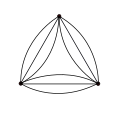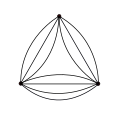Top Qs
Timeline
Chat
Perspective
Shannon multigraph
Three-vertex regular multigraph From Wikipedia, the free encyclopedia
Remove ads
In the mathematical discipline of graph theory, Shannon multigraphs, named after Claude Shannon by Vizing (1965),[1] are a special type of triangle graphs, which are used in the field of edge coloring in particular.
- A Shannon multigraph is multigraph with 3 vertices for which either of the following conditions holds:
- a) all 3 vertices are connected by the same number of edges.
- b) as in a) and one additional edge is added.
More precisely one speaks of Shannon multigraph Sh(n), if the three vertices are connected by , and edges respectively. This multigraph has maximum degree n. Its multiplicity (the maximum number of edges in a set of edges that all have the same endpoints) is .[2][3]
Remove ads
Examples
- Shannon multigraphs
- Sh(2)
- Sh(3)
- Sh(4)
- Sh(5)
- Sh(6)
- Sh(7)
Edge coloring

According to a theorem of Shannon (1949), every multigraph with maximum degree has an edge coloring that uses at most colors.[4] When is even, the example of the Shannon multigraph with multiplicity shows that this bound is tight: the vertex degree is exactly , but each of the edges is adjacent to every other edge, so it requires colors in any proper edge coloring.[3]
A version of Vizing's theorem states that every multigraph with maximum degree and multiplicity may be colored using at most colors.[5] Again, this bound is tight for the Shannon multigraphs.[3]
Remove ads
References
External links
Wikiwand - on
Seamless Wikipedia browsing. On steroids.
Remove ads












